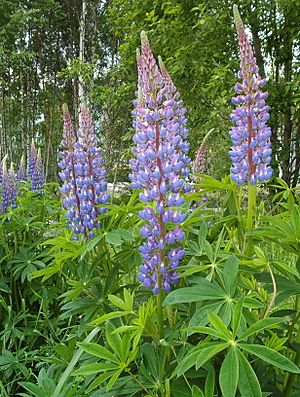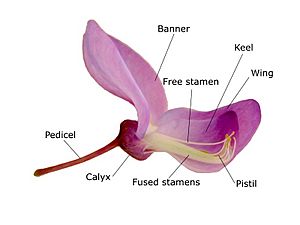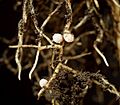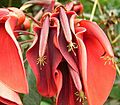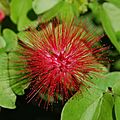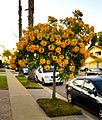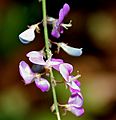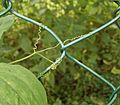Pea family facts for kids
Quick facts for kids Pea family |
|
|---|---|
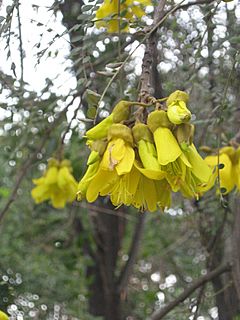 |
|
| Sophora cassioides Kowhai | |
| Scientific classification | |
| Kingdom: | |
| Division: | |
| Class: | |
| Order: | |
| Family: |
Fabaceae
Lindl. (1836)
|
| subfamilia | |
|
Caesalpinioideae |
|
The Fabaceae family, also known as the legume, pea, or bean family, is a very large and important group of flowering plants. You might know them as peas, beans, or lentils! This family includes many different types of plants. Some are tall trees, others are shrubs, and many are smaller plants that live for one year (annuals) or many years (perennials).
You can often spot a legume plant by its special fruit (called a legume or pod) and its unique leaves. The Fabaceae family is found all over the world. It is the third-largest plant family on Earth, with about 751 different groups (genera) and around 19,000 known types of plants (species).
Contents
What Makes Legumes Special?

Legumes come in many shapes and sizes. They can be giant trees, like the Koompassia excelsa, or small annual herbs. Most are herbaceous perennials, meaning they have soft stems and live for more than two years.
Legume plants often have flower clusters that keep growing new flowers. Their flowers have a small cup-like base and a single part that develops into the fruit. After the flower is pollinated, it grows into a legume, which is a type of pod.
How Legumes Grow
Legumes grow in many different ways. They can be trees, shrubs, or smaller plants. Some are even vines that climb or creep along the ground. These climbing plants might twist around other plants or use special parts called tendrils to hold on.
Legumes can be plants that live for one year (annuals), two years (biennials), or many years (perennials). Some love lots of sunlight, while others prefer less light or can grow in dry places.
Legume Leaves
The leaves of legumes are usually arranged alternately along the stem. They are often "compound," meaning each leaf is made up of several smaller leaflets. For example, some have leaflets arranged like feathers (pinnate), while others have three leaflets (trifoliate), like clover. Some, like Lupinus, have leaflets spreading out like fingers (palmate).
Legume leaves always have small leaf-like parts called stipules at their base. These can look like tiny leaves, thorns, or just small bumps. The edges of the leaves are usually smooth, but sometimes they can be slightly toothed.
Many legume leaves and leaflets have special swollen bases called pulvini. These allow the leaves to move, like folding up at night or in strong sunlight. In some plants, like Vicia, parts of the leaflets have changed into tendrils to help the plant climb.
Some legumes have structures on their leaves that attract ants. These ants then protect the plant from insects that might try to eat it. This is a helpful partnership! Some Acacia trees even have hollow stipules where ants live, which are called domatia.
Legume Roots and Nitrogen
Many plants in the Fabaceae family have a special superpower in their roots! They host tiny living things called bacteria inside structures called root nodules. These bacteria are known as rhizobia.
What do these bacteria do? They can take nitrogen gas from the air and change it into a form that the plant can use to grow. This amazing process is called nitrogen fixation. It's like the plant and the bacteria are working together: the plant gives the bacteria a home, and the bacteria give the plant important nutrients. This is a type of symbiosis, where two different living things help each other.
Legume Flowers
Legume flowers often have five sepals (small leaf-like parts that protect the bud) that are usually joined together. They also have five separate petals. Most legume flowers have both male and female parts (hermaphrodite). They usually have ten stamens (the male parts that produce pollen) and one long ovary (the female part that contains the seeds).
These flowers are typically arranged in clusters that keep growing new flowers. Legumes are usually pollinated by insects, so their flowers are often bright and showy to attract pollinators like bees.
Different Flower Shapes
The Fabaceae family is divided into three main groups, and their flowers look a bit different:
- Caesalpinioideae: Flowers in this group are often zygomorphic, meaning they can only be divided into two equal halves in one way, like a human face. An example is Cercis. The top petal is on the inside when the flower is a bud. Some, like Senna, have flowers that are not perfectly symmetrical.
- Mimosoideae: These flowers are usually actinomorphic, meaning they are radially symmetrical, like a star. They are often grouped together in round clusters. The petals are small, but the stamens have long, colorful threads (filaments) that make the flower look showy. All the flowers in a cluster usually open at the same time.
- Faboideae: This group has very special, butterfly-like flowers (called papilionaceous). The top petal is large and often bends backward when the flower opens; this is called the banner. Two side petals, called wings, surround the two bottom petals. The two bottom petals are joined at the tip, forming a boat-like shape called the keel. There are always ten stamens, and their threads can be joined in different ways, often with nine joined together and one separate.
Legume Fruit: The Pod!

The most common fruit of a legume plant is called a legume or a "pod." This is a dry fruit that usually splits open along two sides when it's ripe to release the seeds. Think of a pea pod or a bean pod!
While most legumes produce these classic pods, a few species have evolved different types of fruits. Some might have winged fruits that spin like helicopter seeds, or fruits that don't split open at all. Others might have fruits that look like small berries or drupes (like a cherry).
Images for kids
-
Legume of Vicia sativa
-
Roots of Vicia with white root nodules visible.
-
Cross-section through a root nodule of Vicia observed through a microscope.
-
Indigo colorant
-
The Cockspur Coral Tree Erythrina crista-galli is one of many Fabaceae used as ornamental plants. In addition, it is the National Flower of Argentina and Uruguay.
-
Acacia baileyana (Wattle)
-
Dichrostachys cinerea Sickle Bush
-
Delonix regia tree
-
Tendrils of Lathyrus odoratus (Sweet pea)
-
Inflorescence of Lupinus arboreus (Yellow bush lupin)
-
Pisum sativum (Peas); note the leaf-like stipules
-
Trifolium repens in Kullu District of Himachal Pradesh, India.
-
Cytisus scoparius (Scotch broom)
-
Hosackia stipularis (Stipulate Lotus)
-
Lupinus stiversii (Harlequin Lupine)
See also
 In Spanish: Leguminosas para niños
In Spanish: Leguminosas para niños


